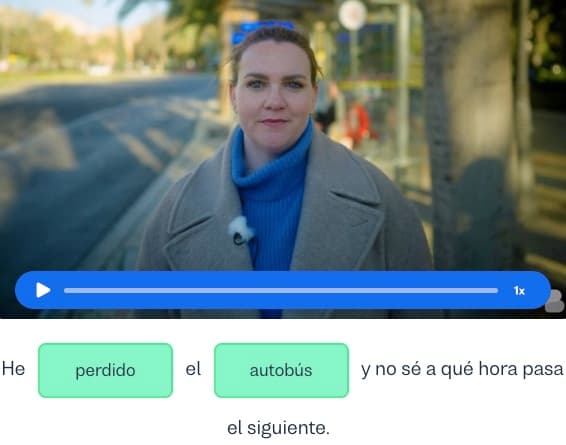I want to learn...
Learning a new language can be both exciting and challenging. Mastering verb conjugation is often a significant hurdle for beginner students.
In Spanish, verbs play a vital role, expressing actions, states, and conditions. Understanding how Spanish present verbs work, including their different tenses and conjugations, is essential for building a strong foundation in the language.
In this article, we will delve into the intricacies of present verbs in Spanish, equipping you with the knowledge necessary to navigate this essential part of the language.
Conjugation basics
The present simple tense, also known as the "presente de indicativo," is used to express usual actions, general truths, or ongoing states in the present. To conjugate regular verbs in the present simple tense, follow these general rules:
For -ar verbs:
yo (-o)
tú (-as)
él/ella/usted (-a)
nosotros/nosotras (-amos)
vosotros/vosotras (-áis)
ellos/ellas/ustedes (-an)For -er verbs:
yo (-o)
tú (-es)
él/ella/usted (-e)
nosotros/nosotras (-emos)
vosotros/vosotras (-éis)
ellos/ellas/ustedes (-en)For -ir verbs, same as -er verbs except for:
nosotros/nosotras (-imos)
vosotros/vosotras (-ís)
Simple present conjugation examples
| Person | -ar example | -er example | -ir example |
|---|---|---|---|
| Yo | Hablo (I speak) | Como (I eat) | Vivo (I live) |
| Tú | Hablas (You speak) | Comes (You eat) | Vives (You live) |
| Él / Ella / Usted | Habla (He/She/You - formal speak) | Come (He/She/You - formal eat) | Vive (He/She//You - formal live) |
| Nosotros | Hablamos (We speak) | Comemos (We eat) | Vivimos (We live) |
| Vosotros | Habláis (You all speak) | Coméis (You all eat) | Vivís (You all live) |
| Ellos / Ellas / Ustedes | Hablan (They/You speak) | Comen (They/You eat) | Viven (They/You all live) |
Present continuous tense
The present continuous tense, also known as the "presente continuo" or "presente progresivo," is used to express actions happening now. To form the present continuous tense in Spanish, follow these steps:
Conjugate the verb estar (to be) in the present simple tense according to the subject.
Add the gerund form (-ando for -ar verbs and -iendo for -er and -ir verbs) of the main verb.
Present continuous tense examples
| Person | -ar example | -er & -ir example |
|---|---|---|
| Yo | Estoy hablando (I am speaking) | Estoy comiendo (I am eating) |
| Tú | Estás hablando (You are speaking) | Estás comiendo (You are eating) |
| Él / Ella / Usted | Está hablando (He/She/You - formal is speaking) | Está comiendo (He/She is eating) |
| Nosotros | Estamos hablando (We are speaking) | Estamos comiendo (We are eating) |
| Vosotros | Estáis hablando (You are speaking) | Estáis comiendo (You are eating) |
| Ellos / Ellas / Ustedes | Están hablando (They/You - formal are speaking) | Están comiendo (They/You are eating) |
Present perfect tense
The present perfect tense, also known as the "pretérito perfecto compuesto," is used to describe past actions or experiences that have a connection to the present. To form the present perfect tense in Spanish, follow these steps:
Conjugate the auxiliary verb haber (to have) in the present simple tense according to the subject.
Add the past participle of the main verb. The endings are only -ado for -ar, and -ido for -er and -ir verbs.
Present perfect tense conjugations
| Person | -ar example | -er & -ir example |
|---|---|---|
| Yo | He hablado (I have spoken) | He comido (I have eaten) |
| Tú | Has hablado (You have spoken) | Has comido (You have eaten) |
| Él / Ella / Usted | Ha hablado (He/She/You - formal has/have spoken) | Ha comido (He/She/You - formal has/have eaten) |
| Nosotros | Hemos hablado (We have spoken) | Hemos comido (We have eaten) |
| Vosotros | Habéis hablado (You all have spoken) | Habéis comido (You all have eaten) |
| Ellos / Ellas / Ustedes | Han hablado (They/You have spoken) | Han comido (They/You have eaten) |
Note: While in Latin Americans the simple past is the most common past tense, in Spain the present perfect is used to convey the same meaning.
Present perfect continuous tense
The present perfect continuous tense, also known as the "pretérito perfecto progresivo," is used to describe ongoing actions that started in the past and continue up to the present. To form the present perfect continuous tense in Spanish, follow these steps:
Conjugate the auxiliary verb haber (to have) in the present simple tense according to the subject.
Add the gerund form (-ando for -ar verbs and -iendo for -er and -ir verbs) of the main verb.
Example conjugations in the present perfect continuous tense
| Person | -ar example | -er & -ir example |
|---|---|---|
| Yo | He estado hablando (I have been speaking) | He estado comiendo (I am eating) |
| Tú | Has estado hablando (You have been speaking) | Has estado comiendo (You have been speaking) |
| Él / Ella / Usted | Ha estado hablando (He/She/You - formal has/have been speaking) | Ha estado comiendo (He/She/You - formal has/have been eating) |
| Nosotros | Hemos estado hablando (We have been speaking) | Hemos estado comiendo (We have been eating) |
| Vosotros | Habéis estado hablando (You all have been speaking) | Habéis estado comiendo (You all have been eating) |
| Ellos / Ellas / Ustedes | Han estado hablando (They have been speaking) | Han estado comido (They have been eating) |
Special cases and exceptions
There are some cases where the rules of present verb conjugation don't apply. Irregular verbs have unique conjugation patterns.
Additionally, stem-changing verbs change their stem vowel for certain pronouns, adding further complexity to their conjugation.
Irregular verbs
While regular verbs follow the aforementioned conjugation patterns, many common Spanish verbs are irregular in the present tense. Irregular verbs have unique conjugations that must be memorized. Ser and estar are three pretty common examples:
Table of irregular verbs
| Person | Ser (to be) | Estar (to be) | Tener (to have) |
|---|---|---|---|
| Yo | Soy | Estoy | Tengo |
| Tú | Eres | Estás | Tienes |
| Él / Ella / Usted | Es | Está | Tiene |
| Nosotros | Somos | Estamos | Tenemos |
| Vosotros | Sois | Estáis | Tenéis |
| Ellos / Ellas / Ustedes | Son | Están | Tienen |
Stem-changing verbs
In addition to irregular verbs, Spanish also has stem-changing verbs. These are also known as "boot verbs" due to their unique conjugation patterns.
Stem-changing verbs undergo changes in the stem vowel in the present tense for all subjects except nosotros/nosotras and vosotros/vosotras. The most common stem changes that occur in -ar and -er verbs:
E → IE (e.g., pensar - to think)
yo pienso
tú piensas
él / ella / usted piensa
nosotros / nosotras pensamos
vosotros / vosotras pensáis
ellos / ellas / ustedes piensanO → UE (e.g., poder - to be able to)
yo puedo
tú puedes
él / ella / usted puede
nosotros / nosotras podemos
vosotros / vosotras podéis
ellos / ellas / ustedes pueden
Spanish, like any language, has its fair share of irregularities and exceptions. Some verbs have spelling changes in certain conjugations, while others may undergo stem changes in the present tense.
It is essential to consult a reliable Spanish grammar resource like the Busuu to learn and practice these special cases.
Reflexive verbs
Reflexive verbs are used to describe actions that a subject performs on themselves. They are formed by adding the reflexive pronoun "se" to the infinitive form of the verb. Reflexive verbs follow regular conjugation patterns with an additional pronoun attached:
Levantarse (to get up)
Yo me levanto
Tú te levantas
Él / ella / usted se levanta
Nosotros / nosotras nos levantamos
Vosotros / vosotras os levantáis
Ellos / ellas / ustedes se levantan
Understanding the regular conjugation patterns, memorizing irregular verbs, and grasping stem-changing and reflexive verbs will greatly enhance your communication skills in Spanish.
Remember, practice is key, so make use of various resources to reinforce your understanding of Spanish present verbs.
With dedication and consistent effort, you'll soon find yourself talking fluently and with confidence with Spanish-speaking natives.
Newlanguages


